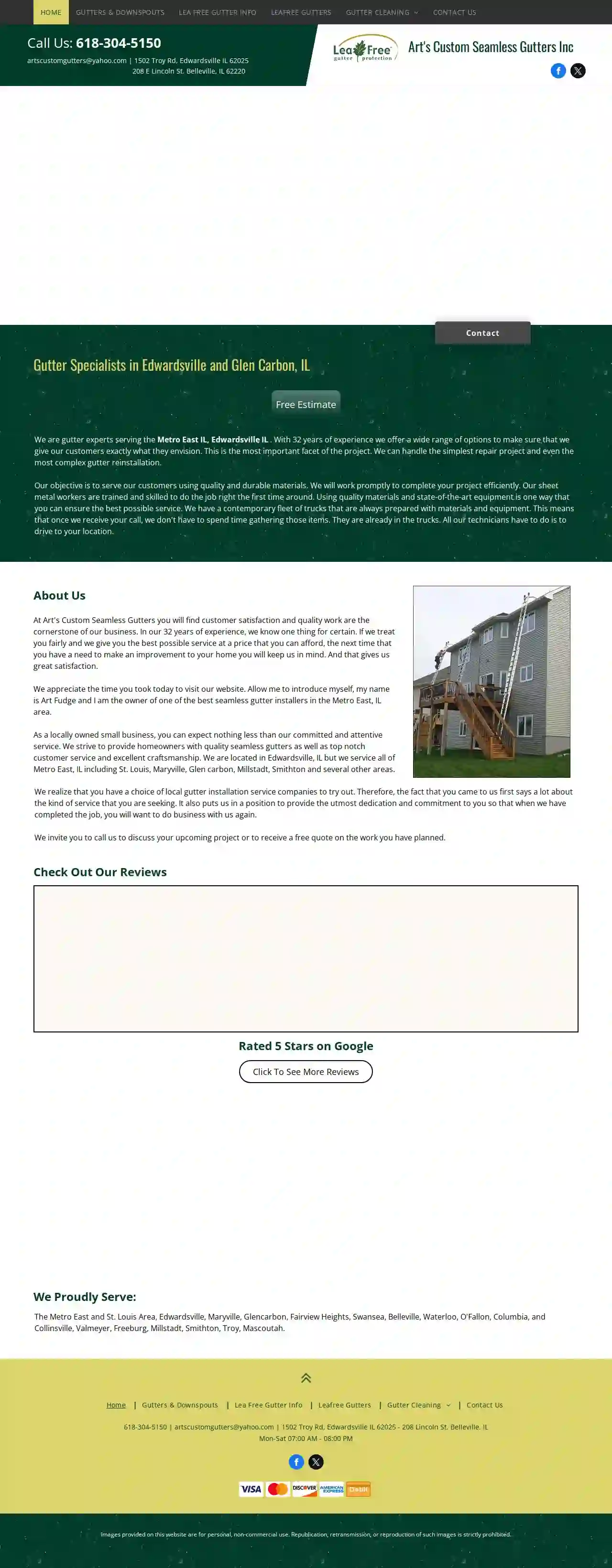Gutter Cleaning Wright City
Find Gutter Cleaning in Wright City
Receive up to 3 Gutter Cleaning and Repair quotes for your project today! Compare profiles, reviews, accreditations, portfolio, etc... and choose the best deal.

See2it Clean
5152 reviews599 Ticino Dr., Imperial, 63052, USSee2it Clean is a professional window cleaning and home exterior detailing service in St Louis, MO providing residential and commercial services for clients in and around the St Louis Metropolitan area. We are honored to serve our team members and customers across the St. Louis area community. Our mission is to serve our team members exceptionally through mentorship and development that will result in a company that consistently creates happy customers and through that success can help transform our community.
- Services
- Why Us?
- Testimonials
- Gallery
Get Quote
Exterior Cleaning Solutions STL
521 reviewsO’Fallon, MO, 11 Porta Drive, 63366, USExterior Cleaning Solutions STL LLC is your home for all things pressure washing in the Saint Louis area! We are proud to be able to serve you and provide you the services you need to feel confident in the state of your property. No matter how big or small the project is, we can tackle it head-on and give you picture-perfect results every time. Contact our team today to learn how to schedule a service for yourself.
- Services
- Why Us?
- Testimonials
- Gallery
Get Quote
Art's Custom Seamless Gutters
4.9129 reviews1502 Troy Rd, Edwardsville IL, Edwardsville, 62025, USGutter Specialists in Edwardsville and Glen Carbon, IL Free Estimate We are gutter experts serving the Metro East IL, Edwardsville IL . With 32 years of experience we offer a wide range of options to make sure that we give our customers exactly what they envision. This is the most important facet of the project. We can handle the simplest repair project and even the most complex gutter reinstallation. Our objective is to serve our customers using quality and durable materials. We will work promptly to complete your project efficiently. Our sheet metal workers are trained and skilled to do the job right the first time around. Using quality materials and state-of-the-art equipment is one way that you can ensure the best possible service. We have a contemporary fleet of trucks that are always prepared with materials and equipment. This means that once we receive your call, we don't have to spend time gathering those items. They are already in the trucks. All our technicians have to do is to drive to your location. About Us At Art's Custom Seamless Gutters you will find customer satisfaction and quality work are the cornerstone of our business. In our 32 years of experience, we know one thing for certain. If we treat you fairly and we give you the best possible service at a price that you can afford, the next time that you have a need to make an improvement to your home you will keep us in mind. And that gives us great satisfaction.We appreciate the time you took today to visit our website. Allow me to introduce myself, my name is Art Fudge and I am the owner of one of the best seamless gutter installers in the Metro East, IL area. As a locally owned small business, you can expect nothing less than our committed and attentive service. We strive to provide homeowners with quality seamless gutters as well as top notch customer service and excellent craftsmanship. We are located in Edwardsville, IL but we service all of Metro East, IL including St. Louis, Maryville, Glen carbon, Millstadt, Smithton and several other areas. We realize that you have a choice of local gutter installation service companies to try out. Therefore, the fact that you came to us first says a lot about the kind of service that you are seeking. It also puts us in a position to provide the utmost dedication and commitment to you so that when we have completed the job, you will want to do business with us again.We invite you to call us to discuss your upcoming project or to receive a free quote on the work you have planned.
- Services
- Why Us?
- Our Team
- Testimonials
- Gallery
Get Quote
Best Quality, LLC
5105 reviewsSt. Louis, USGutter company in St. Louis, MO Locally owned and family-operated complete gutter services company located in St. Louis, MO. We value honesty, and integrity, and treat your home as if it were our own. Our focus is Quality! We pay close attention to the details and guarantee your satisfaction all around. We specialize in providing residential and commercial services. Our customers have given us glowing ratings on HomeAdvisor, Thumbtack, and Google too. Are you looking for a gutter company that provides excellent quality, in addition to great customer service? If so, you have come to the right place. Gutter services We provide a full range of gutter services, including installation, replacement, repair and cleaning of: gutters, gutter-guards, and downspouts. Are you after a new installation? Our “K” style seamless gutters are durable, low-maintenance, and attractive. These gutters have a curved front edge in both 5- and 6-inch sizes. Perfectly match the decor of your property by choosing from our range of 20 different colors. All at an affordable price! Click on services page for more details. Importance of gutters Gutters perform an important role in protecting the integrity of your home. Without gutters, rainwater will run off your roof, potentially causing major damage to your home. This includes foundation, siding, and other important structural components. Gutters help reduce soil erosion and flooding by diverting rainfall away from residences. Taking the time to understand the importance of gutters and maintaining them properly is a necessary step. Altogether, this will ensure that your home stays in a good shape.
- Services
- Why Us?
- Accreditations
- Gallery
Get Quote
St. Louis Gutter Cleaning
St. Louis, USSt. Louis Gutter Cleaning is a trusted local professional gutter cleaning service provider in St. Louis, Missouri. Our dedicated team of experts is committed to ensuring that your gutters receive the attention they deserve, safeguarding your home from potential damage. We understand that ignoring your gutters could cause significant problems for your home. Act now! Maintaining clean and well-maintained gutters is vital for preventing future concerns. Leaves, twigs, and sediment can accumulate, causing clogs that impede proper water flow. Our complete gutter cleaning services are designed to clear away these obstructions, preventing damage to your gutters and mitigating potential problems with your home's foundation. We prioritize the well-being of your home through gutter cleaning. Our skilled professionals can handle gutter repair and replacement with precision and care. By choosing our services, you are investing in the longevity and resilience of your home's infrastructure. Contact the home improvement experts at St. Louis Gutter Cleaning today and experience the difference our dedicated team can make. Safeguard your home – choose us for top-notch gutter services.
- Services
- Why Us?
- Gallery
Get Quote
GutterPros
4.930 reviews1626 N 8th Street, St. Louis, 63102, USAt GutterPros, we guarantee top-notch materials, impeccable workmanship, and unparalleled customer service. With our expertise, we will create a custom gutter system for your home that will leave you worry-free. After all, water goes where we tell it.
- Services
- Why Us?
- Our Team
- Testimonials
- Gallery
Get Quote
Andrew's Custom Gutters
8827 Forest Avenue, St. Louis, MO, 63114, USAndrew's Custom Gutters is a second generation, family owned and operated company serving the St. Louis and surrounding areas for over 16 years. We are dedicated to protecting your home with high-quality custom gutters. We treat every project with the respect and attention it deserves, whether it's clearing away leaves or installing a brand new drainage system. You'll always get our best. Gutters are an important part of your home, diverting water away from the structure and preventing water damage. Don't trust your custom gutter installation, repairs, or cleaning to a subpar business. We have years of experience custom-fitting quality gutters to all types of homes. We'll get the job done right the first time. We'll be happy to walk you through the process and explain why our materials and products are superior to anything else you'll find on the market. We also handle all insurance claims for property damaged by the elements.
- Services
- Why Us?
- Accreditations
- Gallery
Get Quote
St. Louis Gutter Solutions
11 reviewsSt Louis, St Louis, MO, USSt. Louis Gutter Solutions is a professional gutter service provider located in St Louis, MO. We offer a range of services including gutter cleaning, repair, and custom installation. Our team of experts uses state-of-the-art equipment to ensure a thorough and efficient cleaning process. We also install gutter guards to prevent debris from entering your gutters and causing damage. Our goal is to provide exceptional service and ensure your home's gutters are in good hands.
- Services
- Why Us?
- Our Team
- Testimonials
- Gallery
Get Quote
We Get Gutters Clean
10000 Manchester Rd, Suite 100, St Louis, 63101, USWe Get Gutters Clean is a locally owned and operated gutter cleaning company serving the St. Louis, MO area. We are dedicated to providing our customers with high-quality gutter cleaning services at competitive prices. Our team of experienced professionals is committed to providing excellent customer service and ensuring that your gutters are clean and free of debris. We offer a variety of gutter cleaning services, including: * Gutter Cleaning * Gutter Repair * Gutter Installation We also offer free estimates on all of our services. Contact us today to schedule your free estimate!
- Services
- Why Us?
Get Quote
Pro roofing and construction Company LLC | St.Louis Roofing Company
55 reviewsSt. Louis, USWith Over 5 Star Rating Hear about our St.Louis Roofing Services and Remodeling Services from our customers. ABOUT USOur St.Louis Roofing and Remodeling Services GuaranteedBest Warranty in St. Louis to Protect Your Roof and Your Home’s Interior TRUE Estimate - Accurate Estimates Guaranteed for Every Job Best St. Louis Roofing Contractors Based on 5-Star Ratings in Angie’s List, Google Reviews and Facebook Flexible Roofing and Remodeling Schedule and Superior On-Time ServiceMost AffordableRoofing Company and Remodeling CompanyBest St.Louis Roofing Servicesand Remodeling Services WarrantyGet A Quote
- Services
- Why Us?
- Gallery
Get Quote
Over 60,241+ Cleaning Companies onboarded
Our cleaning companies operate in Wright City and beyond!
CleaningMatch has curated and vetted Top Cleaning Contractors arround Wright City. Find the most reliable contractor today.
Frequently Asked Questions About Gutter Cleaning
- Licensing and Insurance: They are licensed, insured, and bonded, providing protection for you and their workers.
- Experience and Expertise: They have a proven track record and experience in gutter cleaning, with trained and knowledgeable professionals.
- Positive Reviews: They have positive online reviews and testimonials from satisfied customers.
- Transparent Pricing: They provide detailed and transparent quotes, outlining all services and costs.
- Professionalism: They are responsive to inquiries, provide clear communication, and arrive on time for appointments.
- Safety Practices: They prioritize safety, using proper equipment and techniques to prevent accidents.
- Guarantees: They offer a satisfaction guarantee or warranty on their work.
- Experience: 'How long have you been in the gutter cleaning business?'
- Licensing and Insurance: 'Are you licensed, insured, and bonded?'
- Cleaning Methods: 'What gutter cleaning methods do you use, and what type of equipment do you have?'
- Gutter Inspections: 'Do you perform a thorough inspection of the gutters before and after cleaning?'
- Pricing: 'How do you price your gutter cleaning services? Do you charge by linear foot, number of stories, or a flat rate?'
- Guarantees: 'Do you offer a satisfaction guarantee or warranty on your work?'
- References: 'Can you provide references from previous clients?'
- Re-Securing Gutters: Tightening or replacing loose fasteners to secure sagging or misaligned gutters.
- Sealing Leaks: Applying sealant or replacing damaged sections to fix leaks at seams or cracks.
- Replacing Damaged Sections: Replacing damaged sections of gutters or downspouts with new matching pieces.
- Downspout Repair: Reattaching separated downspouts, replacing damaged sections, or installing extensions to direct water further away from the foundation.
- Gutter Guard Installation: Installing gutter guards to prevent debris buildup and reduce maintenance.
- Mesh Gutter Guards: Made of fine mesh that allows water to pass through while blocking debris. Relatively inexpensive and effective but may require occasional cleaning.
- Screen Gutter Guards: Similar to mesh guards but with larger openings, making them less prone to clogging but may not block smaller debris.
- Surface Tension Gutter Guards: Feature a curved design that allows water to adhere and flow into the gutter while debris slides off. Effective but can be more expensive.
- Foam Gutter Guards: Made of foam inserts that block debris but can become saturated with water and deteriorate over time.
- Brush Gutter Guards: Consist of bristles that allow water to pass through while blocking larger debris. May require more frequent cleaning than other types.
What are some signs of a reputable gutter cleaning company?
By choosing a gutter cleaning company that demonstrates these qualities, you can have confidence in their professionalism and the quality of their services.
What should I ask a gutter cleaning company before hiring them?
Asking these questions can help you choose a reputable and reliable gutter cleaning company.
What are some common gutter repairs?
A professional gutter repair company can assess your gutters and recommend the most appropriate repairs to restore their functionality and prevent water damage.
How do I choose the right gutter guards?
The best gutter guards for your home depend on your budget, climate, and the type of debris you experience. Consult with a gutter professional to determine the most suitable option for your needs.
What are some signs of a reputable gutter cleaning company?
- Licensing and Insurance: They are licensed, insured, and bonded, providing protection for you and their workers.
- Experience and Expertise: They have a proven track record and experience in gutter cleaning, with trained and knowledgeable professionals.
- Positive Reviews: They have positive online reviews and testimonials from satisfied customers.
- Transparent Pricing: They provide detailed and transparent quotes, outlining all services and costs.
- Professionalism: They are responsive to inquiries, provide clear communication, and arrive on time for appointments.
- Safety Practices: They prioritize safety, using proper equipment and techniques to prevent accidents.
- Guarantees: They offer a satisfaction guarantee or warranty on their work.
By choosing a gutter cleaning company that demonstrates these qualities, you can have confidence in their professionalism and the quality of their services.
What should I ask a gutter cleaning company before hiring them?
- Experience: 'How long have you been in the gutter cleaning business?'
- Licensing and Insurance: 'Are you licensed, insured, and bonded?'
- Cleaning Methods: 'What gutter cleaning methods do you use, and what type of equipment do you have?'
- Gutter Inspections: 'Do you perform a thorough inspection of the gutters before and after cleaning?'
- Pricing: 'How do you price your gutter cleaning services? Do you charge by linear foot, number of stories, or a flat rate?'
- Guarantees: 'Do you offer a satisfaction guarantee or warranty on your work?'
- References: 'Can you provide references from previous clients?'
Asking these questions can help you choose a reputable and reliable gutter cleaning company.
What are some common gutter repairs?
- Re-Securing Gutters: Tightening or replacing loose fasteners to secure sagging or misaligned gutters.
- Sealing Leaks: Applying sealant or replacing damaged sections to fix leaks at seams or cracks.
- Replacing Damaged Sections: Replacing damaged sections of gutters or downspouts with new matching pieces.
- Downspout Repair: Reattaching separated downspouts, replacing damaged sections, or installing extensions to direct water further away from the foundation.
- Gutter Guard Installation: Installing gutter guards to prevent debris buildup and reduce maintenance.
A professional gutter repair company can assess your gutters and recommend the most appropriate repairs to restore their functionality and prevent water damage.
How do I choose the right gutter guards?
- Mesh Gutter Guards: Made of fine mesh that allows water to pass through while blocking debris. Relatively inexpensive and effective but may require occasional cleaning.
- Screen Gutter Guards: Similar to mesh guards but with larger openings, making them less prone to clogging but may not block smaller debris.
- Surface Tension Gutter Guards: Feature a curved design that allows water to adhere and flow into the gutter while debris slides off. Effective but can be more expensive.
- Foam Gutter Guards: Made of foam inserts that block debris but can become saturated with water and deteriorate over time.
- Brush Gutter Guards: Consist of bristles that allow water to pass through while blocking larger debris. May require more frequent cleaning than other types.
The best gutter guards for your home depend on your budget, climate, and the type of debris you experience. Consult with a gutter professional to determine the most suitable option for your needs.